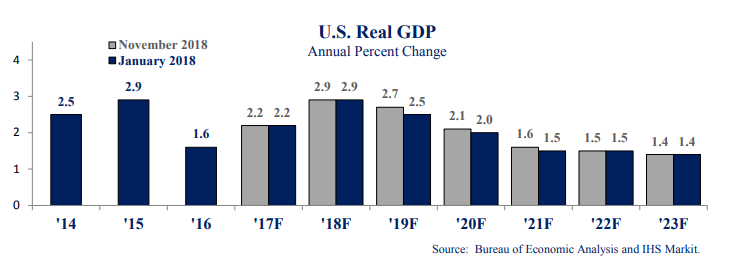The recently released January Revenue and Economic Update gave us unsettling news about the state’s economic and budget landscape. The quarterly report from Minnesota Management and Budget (MMB) shows that recent state revenues have come in lower than anticipated. It also reports that the national economy is expected to continue to grow, but that growth will become quite slow. These two factors could be a potential warning that the $1.5 billion state budget surplus projected in the November Forecast may be too optimistic.
Some of the top takeaways from the Update include:
1. State revenues for the most recent quarter came in below projections. The state’s revenues for November and December came in $102 million below projections; that’s 2.7 percent less than projected in the November 2018 Economic Forecast. The decrease is largely due to lower-than-expected income taxes received. When the January revenues are in, MMB will have a better idea whether this is just a timing issue or an indicator of a more significant trend.
2. Economic growth is expected to be lower. The national economic forecasters predict weaker national GDP growth for 2019 and beyond. The January update predicts 2.5 percent growth in 2019, down from the 2.7 percent predicted in November. Growth is then expected to slow to 1.4 percent by 2023. The slower growth is due to several factors, including tariffs between the U.S. and China and a strong U.S. dollar.

3. The Update does not include the impact of the current federal government shutdown. The economic outlook calculations were done before the shutdown began, and so does not include the impact. However, the state’s economic forecasters expect that this shutdown will place a further drag on national economic growth.
4. National unemployment rate remains low. Nationally, unemployment was 3.9 percent in December, up slightly from November. The Update explains, however, that this slight increase is primarily due to more people who didn’t have a job now feeling confident enough to start looking for one. Since they’re actively looking for jobs but not yet employed, they’re now included in the unemployment numbers.
5. Forecasters are fairly confident in their projections. The forecasters assign a 60 percent chance that their baseline economic forecast is correct. They also give a 25 percent chance for a more pessimistic scenario in which there’s a recession starting next year, and assign a 15 percent probability to a more optimistic scenario.
We’ll get a more complete look at the state’s economic health when the February Forecast comes out later next month. But if we see similar economic growth projections in the February Forecast, that will likely mean lower revenues coming in, and policymakers will have fewer resources to work with as they build the FY 2020-21 budget.
With such slow projected economic growth, the national economy is less resilient, and any sudden shocks to the economy could turn into a recession. It points to the importance of continuing to make investments that support Minnesotans striving to make ends meet. It also underlines why they should protect funding sources for services that Minnesotans count on, including by maintaining the provider tax, a major funding source for affordable health care that will expire on January 1, 2020, if policymakers don’t act.
-Clark Goldenrod